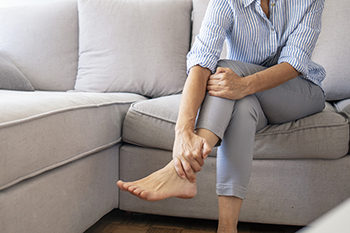
Many people have annoying or even painful problems with their feet that are not caused by an injury. There are four main categories of non-injury foot problems: skin, joints, pain, and numbness. All of these can get worse as the years go by, so it’s wise to be aware of them. Skin problems include plantar warts, calluses, corns, and cracked skin, as well as athlete’s foot and infections. Bunions are the most common joint problems, in addition to hammertoe, gout, bursitis, and arthritis. Pain problems include plantar fasciitis, the most common cause of heel pain. Achilles tendonitis is the second most common source of heel pain. Others are heel spurs, flat feet, and bursitis. Numbness is generally associated with nerve damage caused by diabetes or peripheral artery disease. These conditions are also characterized by burning and tingling sensations in the feet. Other causes of numbness can include sciatica, Morton’s neuroma, and tarsal tunnel syndrome. If you are experiencing foot, toe, or ankle pain, please consult a chiropodist for treatment options.
Foot pain can have many causes. To receive an accurate diagnosis and treatment for your foot pain, please consult with one of the chiropodists from Complete Family Footcare & Therapy. Our clinicians will assess your condition and provide you with quality foot and ankle treatment.
Causes
There are a variety of different conditions that can cause foot pain, including:
Plantar fasciitis
Deformities, such as bunions or hammertoes
Injuries to the muscles, bones, tendons, or ligaments in the feet
Arthritis
Flat feet
Ingrown toenails
Symptoms
The type and location of your foot pain can help determine what may be causing it and what type of treatment options are best for you.
Common types of foot pain include:
Heel pain
Arch pain
Toe pain
Ball of foot pain
Pain that has a stabbing, burning, or tingling quality
Pain that is constant, intermittent, or that gets better or worse depending on the situation
Diagnosis
A thorough medical history and physical examination of your feet will be required to determine a diagnosis. Imaging studies, such as X-rays or MRIs may be performed to rule out or confirm certain diagnoses.
Treatment
Treatment will depend on the cause of the pain. Common treatments for foot pain include resting, icing, compressing, and elevating the affected foot, wearing orthotics, or taking anti-inflammatory medications.
If you have any questions, please feel free to contact our offices located in . We offer the newest diagnostic and treatment technologies for all your foot care needs.
